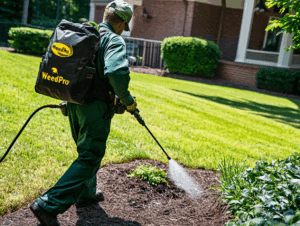When it comes to achieving a lush, green lawn in Atlanta, using the right fertilizers at the right time can make all the difference. Many homeowners are often unsure about which type of fertilizer to choose — starter or maintenance. At Weed Pro, we’ve made it our mission to help Georgia homeowners understand the difference so they can nourish their lawns effectively and avoid common fertilization mistakes. In this guide, we’ll explore what each fertilizer does, when to use them, and how they can transform your lawn care routine for lasting results.
Understanding Fertilizers: Types and Purposes
Fertilizers are essential for providing your lawn with the nutrients it needs to thrive. Fertilizers deliver primary nutrients—specifically nitrogen, phosphorus, and potassium—which are essential for plant growth.
Most fertilizers supply these three key plant nutrients: nitrogen (N), phosphorus (P), and potassium (K), often referred to as NPK. The NPK ratio on fertilizer labels indicates the proportion of these primary nutrients, and understanding this ratio helps ensure your lawn receives the right balance of nitrogen, phosphorus, and potassium for healthy lawn growth. Proper nutrient balance supports optimal plant growth and ensures your lawn receives the lawn nutrients it needs.
What Are Starter Fertilizers?
Starter fertilizers are specially formulated for establishing new seed or laying new sod. These fertilizers typically have a higher phosphorus ratio, which is crucial for robust root development. It is important to apply phosphorus at this stage to support seed germination and early root growth. Common NPK ratios for starter fertilizers include 10-10-10 or 20-10-10. They are applied just before or at the time of planting sod or seeding.
Benefits of Using Starter Fertilizers
The primary benefit of starter fertilizers is that they accelerate root development and promote early germination, supporting healthy growth of new turf and young plants. This means that young grass establishes itself more quickly, adapting better to the surrounding soil conditions. Proper fertilization at this stage helps the plant develop a strong root system. You’ll see thriving patches of green sooner rather than later, providing you with the lawn of your dreams.
What Are Maintenance Fertilizers?
On the other hand, maintenance fertilizers are designed for ongoing nourishment of an existing lawn and established grass. These products typically contain higher nitrogen content relative to phosphorus, with common NPK ratios such as 24-4-12. Established grass requires more nitrogen and other nutrients needed for sustained growth and resilience. Their role is to promote steady grass growth and maintain overall lawn health.
Benefits of Using Maintenance Fertilizers
The benefits of maintenance fertilizers include encouraging consistent growth, enhancing the vibrant green color of your lawn, and improving its resistance to diseases and environmental stresses. Regular maintenance with maintenance fertilizers is especially important during active growth periods to support optimal turf health. By utilizing maintenance fertilizers regularly, you’ll ensure your lawn stays resilient and visually appealing throughout the seasons. Applying fertilizers when the lawn is actively growing maximizes their effectiveness.
Key Differences Between Starter and Maintenance Fertilizers
Knowing when to use the right type of fertilizer is paramount for the successful upkeep of your lawn. Selecting the best lawn fertilizer, including specialized feed products that combine nutrients and weed control, is essential for achieving a beautiful lawn.
What is the difference between starter and maintenance fertilizers?
Starter fertilizers are high in phosphorus to aid new grass root development, while maintenance fertilizers focus on providing ongoing nourishment to established lawns with higher nitrogen content.
Both synthetic fertilizers and organic fertilizer can supply not only the primary nutrients (nitrogen, phosphorus, and potassium) but also other nutrients, such as essential micronutrients, to support overall plant health and soil fertility.
When to Use Starter Fertilizers
Starter fertilizers should be applied just before laying sod or planting seed. This application aids new grasses in establishing a strong foundation. If soil tests indicate a phosphorus deficiency, you may consider applying starter fertilizer even later in the lawn’s lifecycle but generally, it’s not recommended for mature lawns.
When to Use Maintenance Fertilizers
In contrast, maintenance fertilizers are necessary for regular feeding of established lawns. Plan to apply fertilizer to your lawn during the growing season, including spring, summer, and early fall, to maximize growth and health. Regular applications help maintain nutrient levels in the soil, ensuring your lawn retains its lush appearance. It is important to apply fertilizer at the right times to maintain optimal nutrient levels and support healthy grass growth.
Choosing the Right Fertilizer for Your Lawn
Choosing the right lawn fertilizer is key to providing essential nutrients your grass needs for healthy growth. Selecting the right fertilizer isn’t a one-size-fits-all scenario. Here are some factors to consider to maximize your lawn’s health and appearance. Always check the label for the percentage of actual nutrient in the product, and be aware of local regulations regarding phosphorus fertilizers before making your selection.
Factors to Consider: Soil Type, Climate, and Grass Variety
- Soil Type: Different soil types affect nutrient retention and availability. For example, sandy soils may require more frequent feeding.
- Climate: Atlanta’s warm climate means you need to consider the effect of rain on nutrient leaching, which can affect how often you need to apply fertilizers.
- Grass Variety: Different lawn grasses, including warm season grasses and cool season grasses, have unique nutrient requirements. For example, warm season grasses thrive during the summer and require specific fertilization strategies, while cool season grasses benefit from targeted care in the fall and winter. Understanding the needs of your grass plants will help you select the most effective fertilizer. Researching which fertilizers suit your grass type will give you the best results.
How to Apply Fertilizers Effectively
- Apply starter fertilizer evenly across the area before covering with sod or seed. You can choose between granular fertilizers, which are spread over the soil and provide slow, long-lasting nutrient release, or liquid fertilizer, which is applied with a sprayer and offers quick nutrient uptake for rapid green-up—especially useful for small lawns or when immediate results are desired.
- For maintenance fertilizers, be sure to spread them uniformly on your established lawn, avoiding overlap to prevent burnt patches. Granular fertilizer is commonly used for steady, sustained feeding, while liquid fertilizer can be used for fast-release effects. Weed and feed products are also an option, combining fertilization and weed control in a single application for added convenience, but be mindful of proper usage to avoid potential harm to your lawn or the environment.
- Always water your lawn thoroughly after application to help the nutrients absorb into the soil.
To conclude, your choice between starter and maintenance fertilizers can significantly affect the health and aesthetics of your lawn. Apply starter fertilizers when establishing a new lawn to support initial growth, and switch to maintenance fertilizers once your grass is well-rooted to ensure its continued vitality. By understanding the specific needs of your lawn, considering soil conditions and climate, and applying fertilizers effectively, you’ll partner with Weed Pro to cultivate a vibrant, healthy yard that stands out in Atlanta’s landscape.
Environmental Impact of Fertilizer Use
Using lawn fertilizers can have a lasting impact on the environment if not managed responsibly. When excess phosphorus or nitrogen from fertilizers washes off your lawn, it can enter local waterways, leading to pollution and harmful algae blooms that disrupt aquatic life. To protect both your lawn and the environment, start with a soil test to determine exactly what nutrients your soil needs—this helps you avoid applying unnecessary fertilizer and reduces the risk of excess phosphorus runoff.
Opting for slow release fertilizers and natural organic fertilizers can further minimize environmental impact by providing nutrients gradually, which helps prevent leaching and runoff. Incorporating soil amendments and organic fertilizers not only supports a healthy lawn but also improves soil structure and nutrient retention. Homeowners can also reduce fertilizer runoff by maintaining a dense, healthy lawn through proper mowing, watering, and the use of soil amendments. By making informed choices and following best practices, you can enjoy a vibrant lawn while safeguarding the environment.
Fertilizer Safety Tips for Homeowners
Ensuring a healthy lawn starts with safe fertilizer use. Always read and follow the label instructions for your chosen fertilizer, paying close attention to recommended application rates and timing. When handling fertilizers, wear gloves, long sleeves, and eye protection to prevent skin and eye irritation. Store fertilizers in a secure, well-ventilated area, out of reach of children and pets.
Avoid applying fertilizers on windy or rainy days to prevent drift and runoff, and never use fertilizers near water sources or storm drains. After applying fertilizer, wash your hands thoroughly and keep all fertilizers away from food and drinking water. By following these simple safety tips, you can protect your family, pets, and the environment while achieving a lush, healthy lawn.
Common Mistakes to Avoid When Fertilizing Your Lawn
Fertilizing your lawn can yield great results, but common mistakes can undermine your efforts and even harm your lawn. One major pitfall is skipping a soil test or soil testing, which can lead to applying the wrong type or amount of fertilizer. Without knowing your soil pH and nutrient levels, you risk over-fertilizing, which can cause fertilizer burn, reduce nutrient availability, and damage lawn health.
Another frequent error is using a fertilizer with too much phosphorus, especially if your soil already contains adequate levels. This not only wastes resources but can also contribute to environmental issues. Applying fertilizer at the wrong time or in excessive amounts can further stress your lawn and reduce its resilience.
To avoid these mistakes, always start with a soil sample and follow soil test results to guide your fertilizer choices. Pay attention to your grass type, local climate, and soil amendments to ensure you’re providing the right nutrients at the right time. Regular lawn maintenance—including proper mowing, watering, and soil care—will help you maintain a healthy lawn and prevent common fertilization errors. By staying informed and attentive, you’ll enjoy a beautiful, thriving lawn year-round.
Frequently Asked Questions
What is the difference between starter and maintenance fertilizers?
Starter fertilizers are high in phosphorus to aid new grass root development, while maintenance fertilizers focus on providing ongoing nourishment to established lawns with higher nitrogen content.
When should I use starter fertilizers on my lawn?
Starter fertilizers should be applied just before laying sod or planting seeds. They promote early germination and robust root establishment, crucial for new lawns.
How often should I apply maintenance fertilizers?
Maintenance fertilizers should be applied during key growing seasons—spring, summer, and fall—to ensure your established lawn retains its lush, green appearance.
Can I use starter fertilizer on an established lawn?
It’s generally not recommended to use starter fertilizer on mature lawns unless soil tests indicate a phosphorus deficiency. Maintenance fertilizers are more suitable for established lawns.
What nutrients do starter and maintenance fertilizers provide?
Both types of fertilizers supply essential nutrients, primarily nitrogen (N), phosphorus (P), and potassium (K), crucial for the growth and health of your lawn.
How do I choose the right fertilizer for my lawn?
Consider factors like soil type, climate, and grass variety. Different soils may require varied feeding frequencies, and understanding your grass’s nutrient needs will yield the best results.







